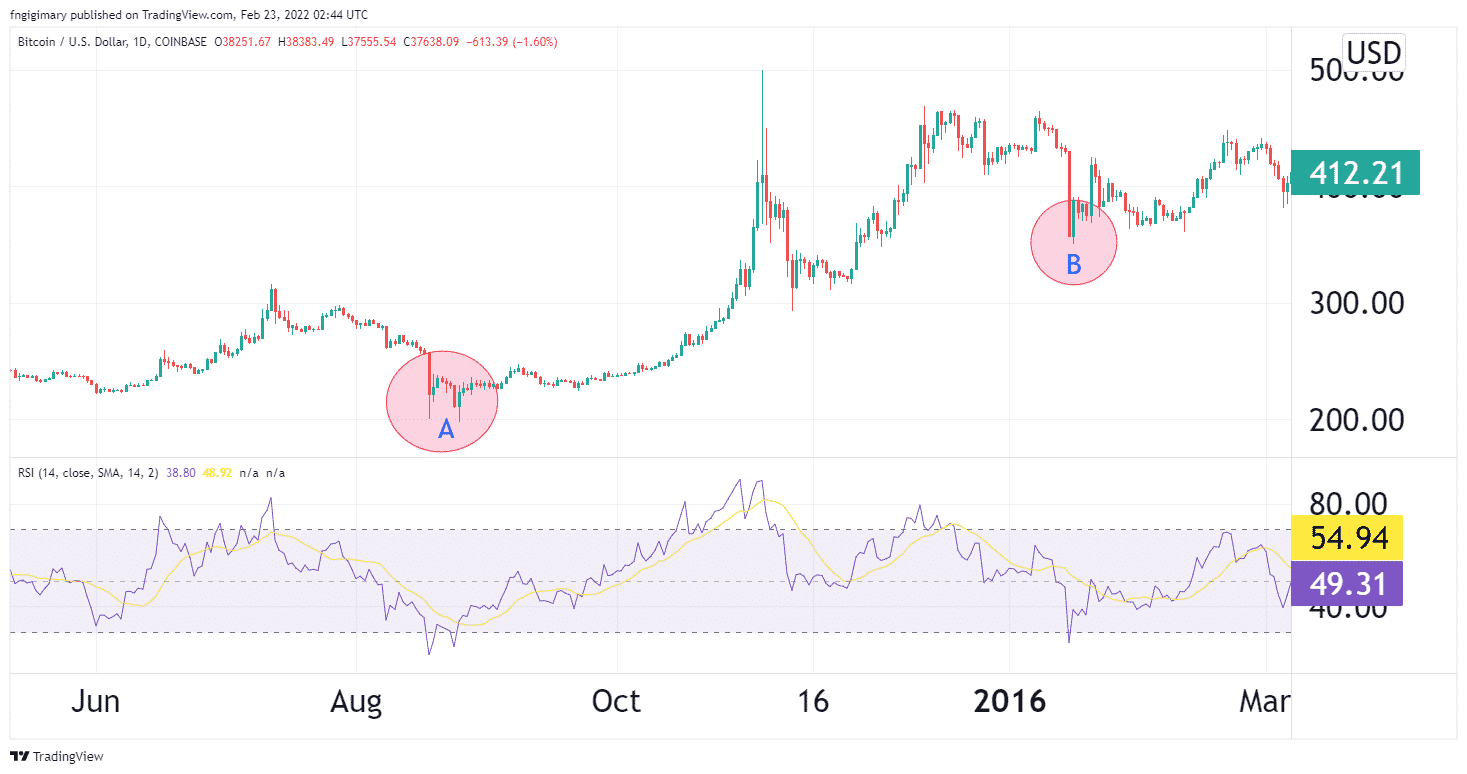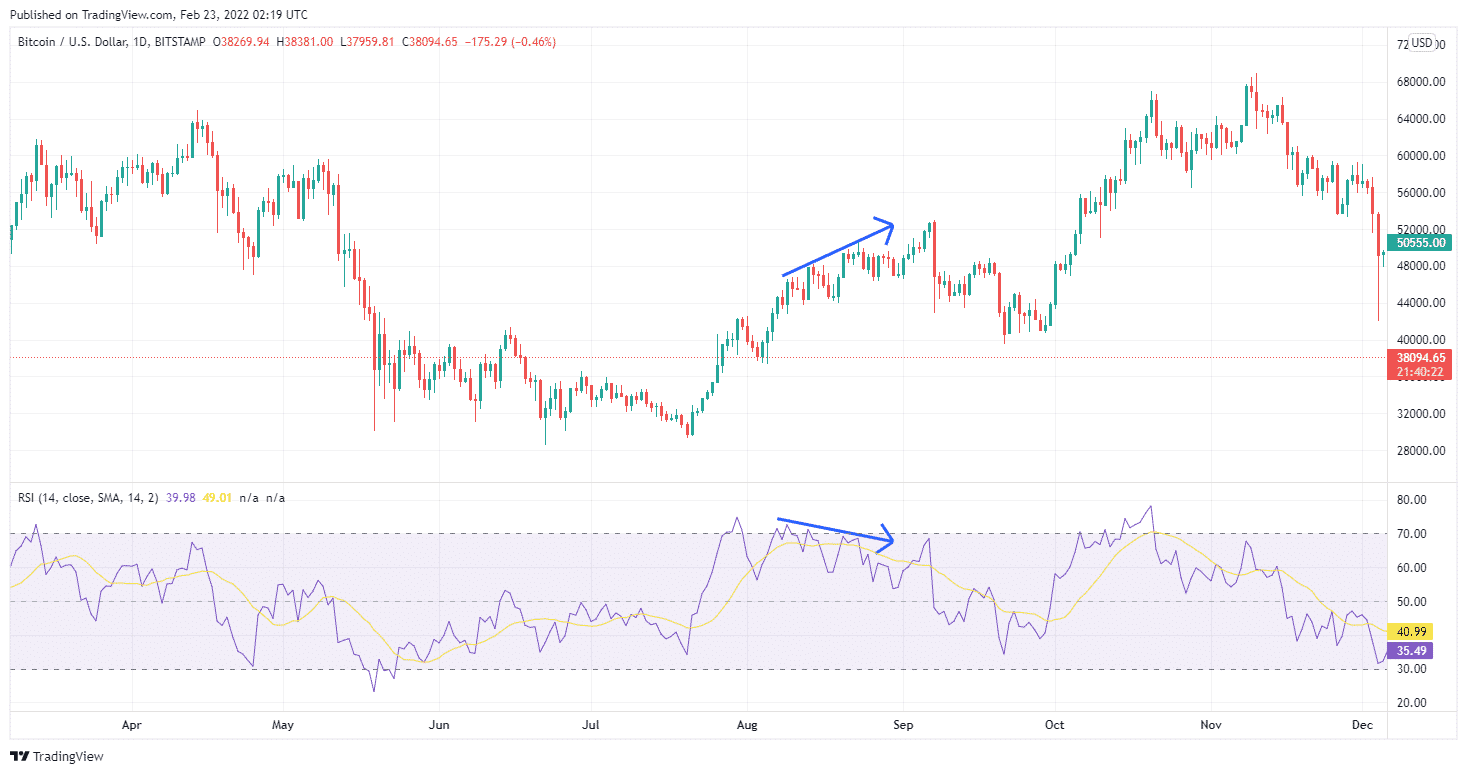The RSI was created in 1978 and is still one of the most widely used public-domain indicators today. It is a go-to technical tool for legions of active crypto traders due to the volatile nature of the cryptocurrency markets. It is one of the most widely used momentum oscillators. Momentum oscillators are a set of indicators that are used to determine if a market is overbought or oversold. They’re based on pricing, but they’re scaled so that they “oscillate” between a high and low value (0–100).
Definition
It is a momentum and speed indicator that measures how fast the crypto price is moving. Its output can be used to detect whether assets like Bitcoin are overbought or oversold.
Its core is based on the average upward price move vs. the average downward price change during a certain time period. RSI examines the change in the price of a crypto or stock asset over a default 14-period time frame. The time frame, on the other hand, can be adjusted to fit a trader’s investing horizon. It can be measured in weeks, days, hours, or even minutes.
Formulae

All computations are carried out automatically by modern crypto trading platforms. The RSI readings are then graphed as a single line beneath the price, with a value ranging from 0 to 100. All a cryptocurrency trader has to do is examine the RSI’s value to interpret it. If it’s above 70, the market is overbought and if it’s below 30, the market is oversold.
Strategies
1. Overbought
The RSI can assist you predict when a cryptocurrency will drop, even if it’s only for a short time. Overbought circumstances in the oscillator reflect this period in time. The higher the RSI rises above 70.00, the more overbought the asset is and the greater the potential for a market correction.

The chart above shows three instances (A, B, and C) where the RSI suggested overbought conditions. The price dropped during the next few days or weeks. When a trader’s position is overbought, it’s a good idea to take a profit or close it totally.
2. Oversold
The RSI can also indicate when a falling price is nearing exhaustion. The lower the RSI falls below 30, the more oversold the asset is and the more likely a price will rise.

The chart above shows two instances (A and B) where the RSI suggested oversold conditions. The price rises in the next few days or weeks.
3. Divergence
When the price makes a higher high or lower low while the oscillator produces a lower high or lower low, this is known as divergence. The bearish and bullish positions are indicated.
A bullish divergence signal is indicated by a lower low price and a contrasting higher low on the RSI. This indicates that the crypto asset is acquiring traction for an upward move. However, this has yet to be reflected in the price movement. You could place a buy order if you see a double bottom with a bullish divergence pattern.
A bearish divergence, on the other hand, happens when the price is at a higher high while the RSI is at a lower high. It’s a signal of a price drop to come. When a double top exhibits bearish divergence, it may be time to sell.
We assume that there will be no new bottom, your stop loss can be positioned below the prior low. If a new low is formed, the analysis has been proven incorrect, and your stop loss will be reached.

In the chart above, the price making a higher high (blue arrow), while the RSI is making a lower high (black arrow). This is a bearish divergence, and the price eventually falls since the buying power is insufficient to sustain it.
What to look out when trading crypto using RSI
Risk management
Risk management is becoming increasingly critical as the cryptocurrency markets become more volatile. Keep in mind that the RSI is simply a technical indicator and it has its own flaws. The only way to assure that it succeeds is to apply the approach consistently over time; if this is done, profit and loss become products of reality rather than luck. Never risk more than 3% of your account balance on a single cryptocurrency trade, according to one sound risk management method. This method, known as the “3% rule,” preserves the trading account while chasing profitability. Also, make sure to set a stop loss for each trade.
False signals
When the RSI readings rise above 70 or fall below 30, and the price does not reverse, this is known as a false signal. This is a regular occurrence in cryptocurrencies that are seeing a strong trend. As a result of the bullish or bearish price action failing to reach exhaustion, false buy or sell signals are generated. The RSI is best utilized in conjunction with other technical or fundamental indicators to overcome this flaw. To optimize the indicator’s effectiveness, many traders combine it with Bollinger Bands, moving averages, or Fibonacci retracements.
Bottom line
Like all price action–derived indicators, the RSI displays a smoothed representation of the current market activity. To use RSI, you don’t need to know the formulae because it’s drawn by default in many charting applications. The RSI is a great tool, but it, like all other indicators, can provide a lot of false information, therefore it’s best to use it in conjunction with other indications or backtest it extensively. RSI trading strategies that help you know when to enter or exit a trade are; when it is oversold or overbought and when there is either a bullish or bearish divergence.
